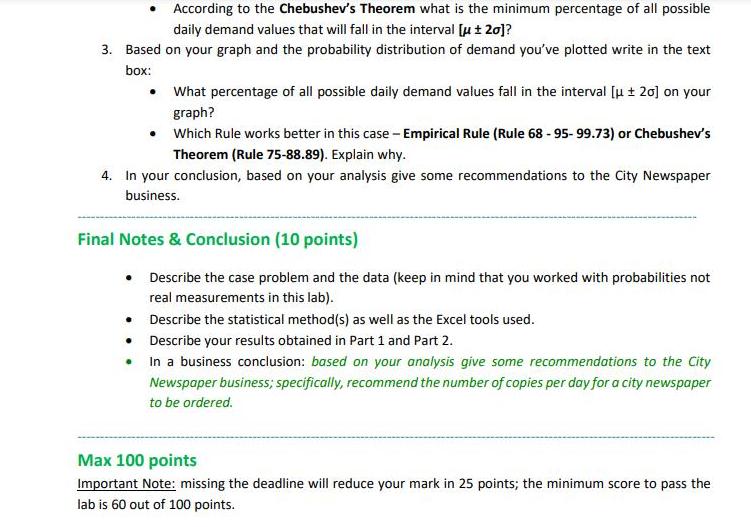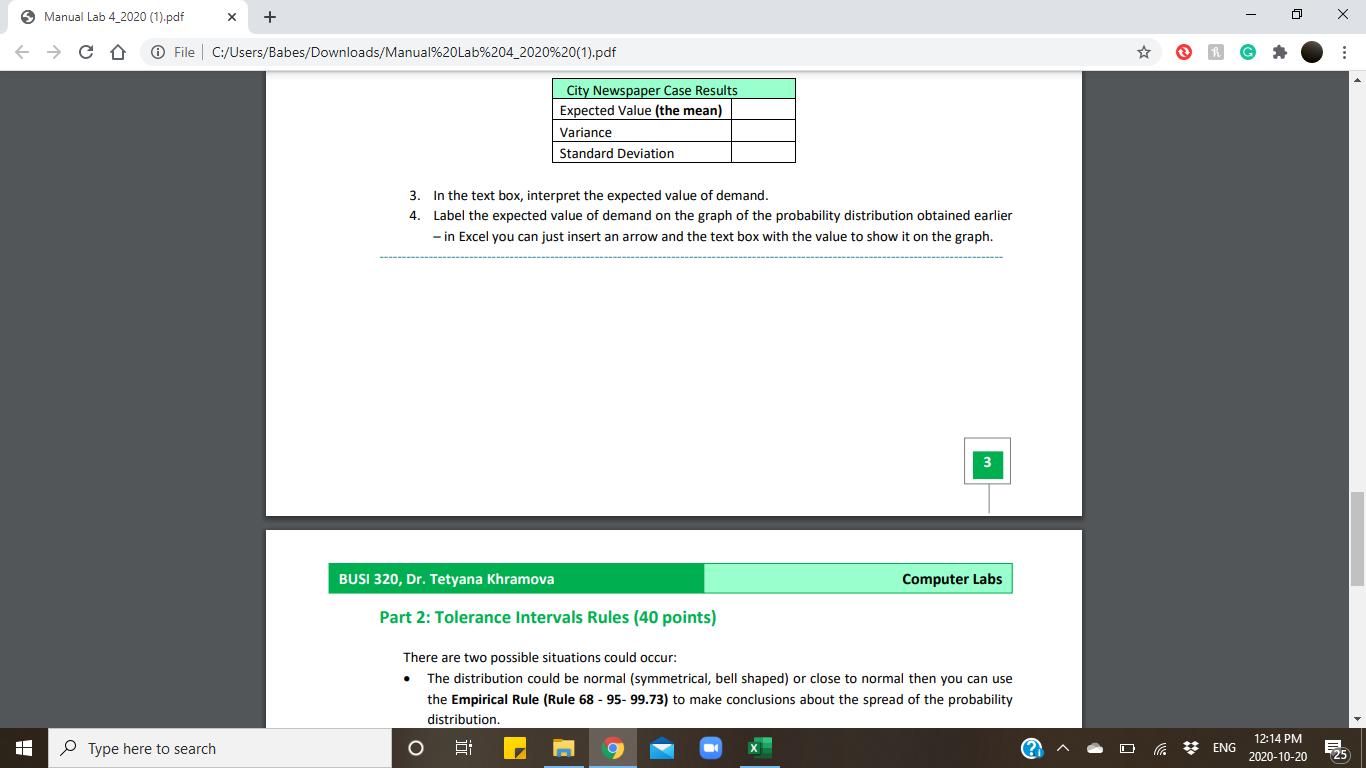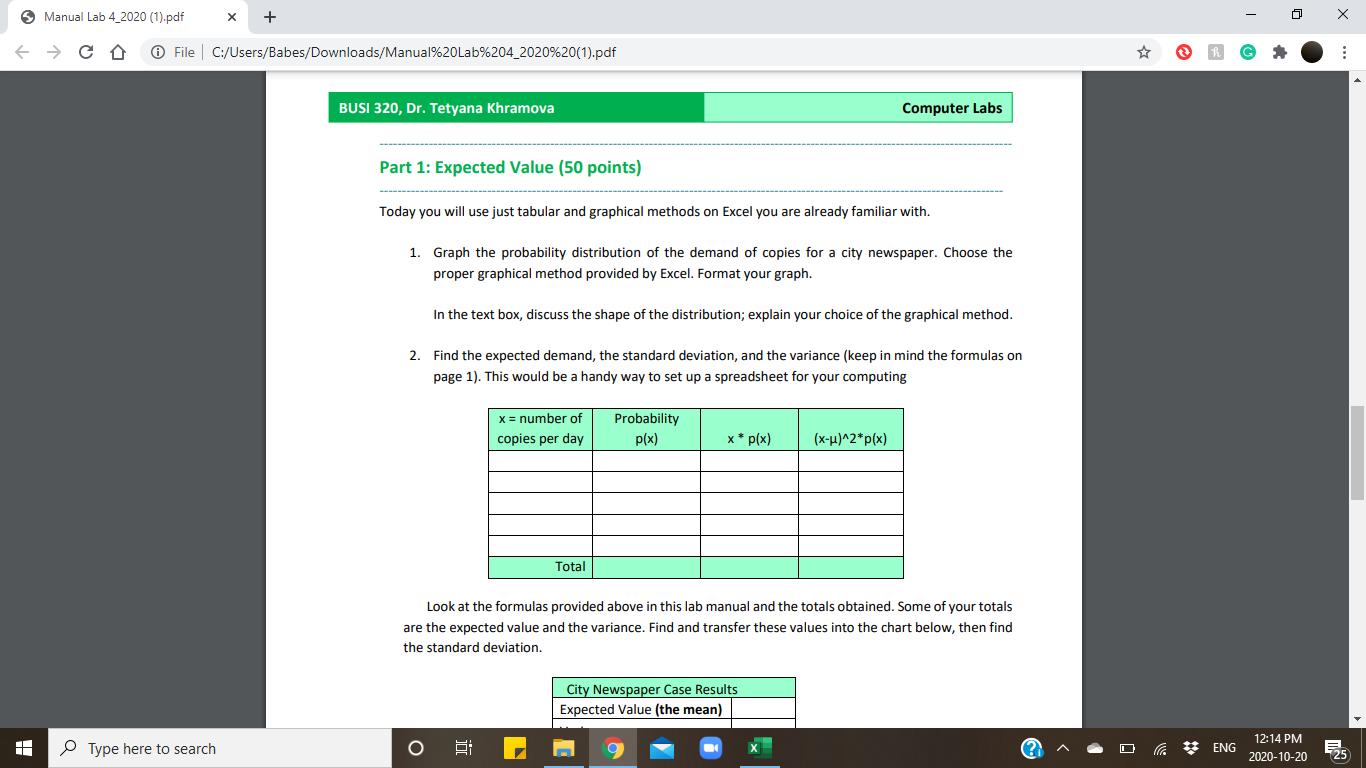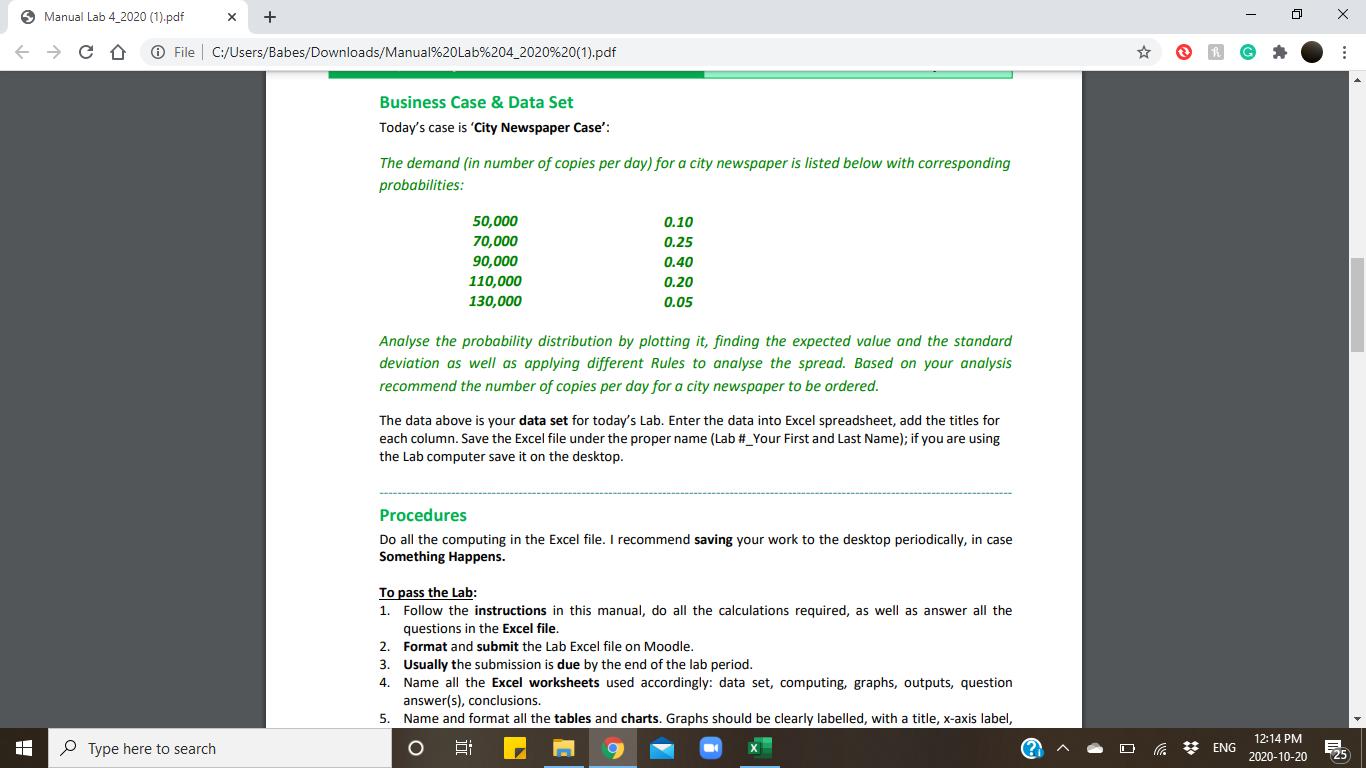Answered step by step
Verified Expert Solution
Question
1 Approved Answer
According to the Chebushev's Theorem what is the minimum percentage of all possible daily demand values that will fall in the interval [ 20]?





According to the Chebushev's Theorem what is the minimum percentage of all possible daily demand values that will fall in the interval [ 20]? 3. Based on your graph and the probability distribution of demand you've plotted write in the text box: What percentage of all possible daily demand values fall in the interval [ 20] on your graph? Which Rule works better in this case - Empirical Rule (Rule 68-95-99.73) or Chebushev's Theorem (Rule 75-88.89). Explain why. 4. In your conclusion, based on your analysis give some recommendations to the City Newspaper business. Final Notes & Conclusion (10 points) Describe the case problem and the data (keep in mind that you worked with probabilities not real measurements in this lab). Describe the statistical method(s) as well as the Excel tools used. . Describe your results obtained in Part 1 and Part 2. In a business conclusion: based on your analysis give some recommendations to the City Newspaper business; specifically, recommend the number of copies per day for a city newspaper to be ordered. . Max 100 points Important Note: missing the deadline will reduce your mark in 25 points; the minimum score to pass the lab is 60 out of 100 points. Manual Lab 4_2020 (1).pdf CO + X + File C:/Users/Babes/Downloads/Manual%20Lab%204_2020%20(1).pdf Type here to search Part 2: Tolerance Intervals Rules (40 points) There are two possible situations could occur: The distribution could be normal (symmetrical, bell shaped) or close to normal then you can use the Empirical Rule (Rule 68 - 95-99.73) to make conclusions about the spread of the probability distribution. . If you are not sure that the distribution is normal or close to normal you still can discuss the tolerance intervals. In this case it is better to apply the Chebushev's Theorem (Rule 75-88.89) to make conclusions about the spread of the probability distribution. 1. Calculate the interval [ 20]. Illustrate the interval [ 20] on the graph (use arrows and text boxes with values). 2. Now apply both Rules to interpret this tolerance interval. Write your answers for the following questions in the text box: According to the Empirical Rule what is the minimum percentage of all possible daily demand values that will fall in the interval [ 20]? According to the Chebushev's Theorem what is the minimum percentage of all possible daily demand values that will fall in the interval [ 20]? 3. Based on your graph and the probability distribution of demand you've plotted write in the text box: What percentage of all possible daily demand values fall in the interval [ 20] on your graph? Which Rule works better in this case - Empirical Rule (Rule 68-95-99.73) or Chebushev's Theorem (Rule 75-88.89). Explain why. 4. In your conclusion, based on your analysis give some recommendations to the City Newspaper business. . . . Final Notes & Conclusion (10 points) Describe the case problem and the data (keep in mind that you worked with probabilities not real measurements in this lab). Describe the statistical method(s) as well as the Excel tools used. 6: #ENG 0 X 12:14 PM 2020-10-20 : (25 Manual Lab 4_2020 (1).pdf File CO + X Type here to search + C:/Users/Babes/Downloads/Manual%20Lab%204_2020%20(1).pdf 3. 4. BUSI 320, Dr. Tetyana Khramova City Newspaper Case Results Expected Value (the mean) Variance Standard Deviation In the text box, interpret the expected value of demand. Label the expected value of demand on the graph of the probability distribution obtained earlier - in Excel you can just insert an arrow and the text box with the value to show it on the graph. Part 2: Tolerance Intervals Rules (40 points) 3 Computer Labs There are two possible situations could occur: The distribution could be normal (symmetrical, bell shaped) or close to normal then you can use the Empirical Rule (Rule 68 - 95-99.73) to make conclusions about the spread of the probability distribution. #ENG 0 X 12:14 PM 2020-10-20 : (25 Manual Lab 4_2020 (1).pdf File CO + X + C:/Users/Babes/Downloads/Manual%20Lab%204_2020%20(1).pdf Type here to search BUSI 320, Dr. Tetyana Khramova Part 1: Expected Value (50 points) Today you will use just tabular and graphical methods on Excel you are already familiar with. 1. Graph the probability distribution of the demand of copies for a city newspaper. Choose the proper graphical method provided by Excel. Format your graph. In the text box, discuss the shape of the distribution; explain your choice of the graphical method. 2. Find the expected demand, the standard deviation, and the variance (keep in mind the formulas on page 1). This would be a handy way to set up a spreadsheet for your computing O x = number of copies per day 6: Total Probability p(x) x* p(x) Look at the formulas provided above in this lab manual and the totals obtained. Some of your totals are the expected value and the variance. Find and transfer these values into the chart below, then find the standard deviation. City Newspaper Case Results Expected Value (the mean) 9 Computer Labs (x-)^2*p(x) ? #ENG 0 X 12:14 PM 2020-10-20 : (25 Manual Lab 4_2020 (1).pdf C + X + File | C:/Users/Babes/Downloads/Manual%20Lab%204_2020%20(1).pdf Type here to search Business Case & Data Set Today's case is 'City Newspaper Case': The demand (in number of copies per day) for a city newspaper is listed below with corresponding probabilities: 50,000 70,000 90,000 110,000 130,000 0.10 0.25 0.40 0.20 0.05 Analyse the probability distribution by plotting it, finding the expected value and the standard deviation as well as applying different Rules to analyse the spread. Based on your analysis recommend the number of copies per day for a city newspaper to be ordered. The data above is your data set for today's Lab. Enter the data into Excel spreadsheet, add the titles for each column. Save the Excel file under the proper name (Lab #_Your First and Last Name); if you are using the Lab computer save it on the desktop. Procedures Do all the computing in the Excel file. I recommend saving your work to the desktop periodically, in case Something Happens. To pass the Lab: 1. Follow the instructions in this manual, do all the calculations required, as well as answer all the questions in the Excel file. 2. Format and submit the Lab Excel file on Moodle. 3. Usually the submission is due by the end of the lab period. 4. Name all the Excel worksheets used accordingly: data set, computing, graphs, outputs, question answer(s), conclusions. 5. Name and format all the tables and charts. Graphs should be clearly labelled, with a title, x-axis label, 9 Hi #ENG 0 X 12:14 PM 2020-10-20 : (25
Step by Step Solution
★★★★★
3.39 Rating (174 Votes )
There are 3 Steps involved in it
Step: 1
ANSWER Chebyshevs theorem estimates the minimum proportion of data within a certain number of standa...
Get Instant Access to Expert-Tailored Solutions
See step-by-step solutions with expert insights and AI powered tools for academic success
Step: 2

Step: 3

Ace Your Homework with AI
Get the answers you need in no time with our AI-driven, step-by-step assistance
Get Started


